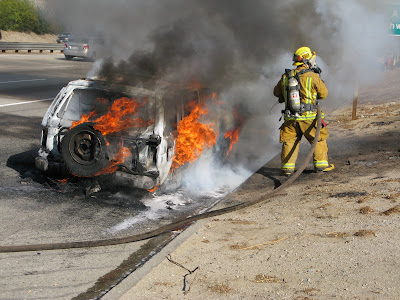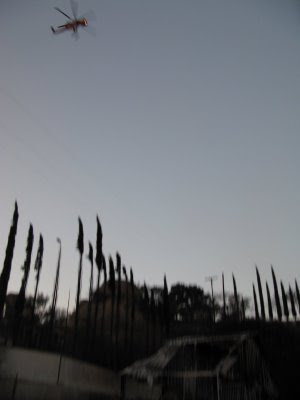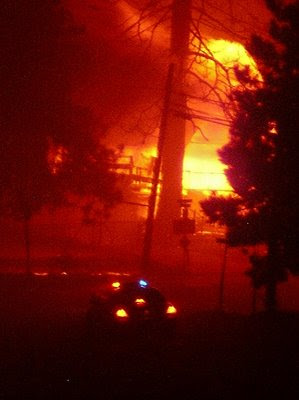
Dusk falls near Mayan Drive
By Guy McCarthy
PORTER RANCH - From San Bernardino to the San Fernando Valley, gusting winds held the upper hand Monday, severely limiting what firefighters and pilots could do as out-of-control fires burned an estimated 10,000 acres, destroyed more than a dozen homes, and contributed to at least one death.
"It was hell, hell in the mountains," said Abdessamad Elyamani, a doctor who feared for the lives of his wife and children as Santa Ana winds hurled a storm of flames and embers into their hillside community.
"I saw it coming so fast," said Elyamani, who lives near the high end of Topanga Canyon Boulevard. "Two or three minutes, that is all. It was huge fumes of smoke and flames, and we could not breathe. It was jumping all over. Embers were flying and starting fires everywhere."
Los Angeles County fire Capt. Tim Bauer and a strike team of five engine crews from East Los Angeles arrived about 11 a.m. and did what they could.
"Winds were reported 75 mph here. It was a firestorm," Bauer said. "Embers were flying sideways into the houses. As soon as we got here, the fire was right upon us."
Bauer and his crews took a chance trying to defend a ridgetop neighborhood with narrow, winding roads and limited water. Several homes burned, but they managed to save more than the flames destroyed.
"We took risks taking the high ground, yes," Bauer said. "But it's risk versus gain. We were sheltered somewhat behind the houses. . . . No, it's not a safe place for a firefight. Narrow streets, hilltop, and only a few hydrants."
Elyamani's home did not burn, but several of his neighbors' homes further uphill on Mayan Drive were gutted.
"We will try to spend the night," Elyamani said, walking down from Mayan as a smoky, orange dusk turned slowly to darkness. "But you see these embers on the hill? If they cross the street we are gone."
He pointed at the slope across the road from his home as wind fanned tiny, glowing hot spots into flames. He turned towards his home with his wife and boys, ages 4 and 8.
"We hope we are going to be okay."
Earlier Monday, about 80 miles east at the Forest Service Tanker Base in San Bernardino, aviation officer Tom Inocencio said blasting winds and turbulence in the morning prevented he and his pilot from making it to the fires burning in the San Fernando Valley.
"They sent us to the fire at Little Tujunga, the one they call Marek," Inocencio said. "We made it to west of Cucamonga Peak, above Rancho and Ontario, but we had updrafts and downdrafts coming off the mountains.
"We were losing and gaining 2,000 feet elevation per minute," Inocencio said. "It was like being weightless for a second, then getting jammed down in your seat. Wilder than a rollercoaster."
Inocencio and private contract pilot Ryan Litten were in a twin-engine Aero Commander, a lead plane for tankers that drop retardant and water. The blasting winds kept many aircraft grounded at the same time the fires blew up, according to accounts at the tanker base and in the Porter Ranch area.
"It's a decision we have to make sometimes," Litten said. "Every aircraft has limitations and if conditions exceed those limitations we have to set it down. It wasn't fun this morning. Everything in the cabin was flying around."
Inocencio said he learned the winds had grounded all fixed-wing tankers flying out of Lancaster. Watching television coverage of the fires in the San Bernardino tanker base kitchen, Inocencio drew a few conclusions.
"These aren't the kinds of fires where aircraft are effective," Inocencio said. "The winds just take the water or retardant and spread it out. Drops just drift away, off target. When it blows this hard, the real work gets done on the ground."
It was about 1:30 p.m. By that time, Inocencio said he'd had to turn down two additional dispatches because of the winds.
"We're getting 30 knot cross-winds here right across the deck," Inocencio said. "We had sustained readings at Santiago Peak in Orange County of 70 mph. Top speed gust reading was 117 mph at Santiago."
Some helicopter pilots in Los Angeles County managed to fly, and by late afternoon tanker planes made at least a few drops on the fires in the San Fernando Valley. Earlier in the day, Inocencio said some of the aerial attacks were just for show.
"It looks good because people want to see their tax dollars at work," Inocencio said. "But it's risk versus gain. Is it worth the risk to put on a show like that, when it doesn't do much on the fire?
"It's been a rough day so far. Maybe tomorrow will be better. But the latest models show the winds will keep going into Wednesday."
-30-

Photos by Guy McCarthy






















